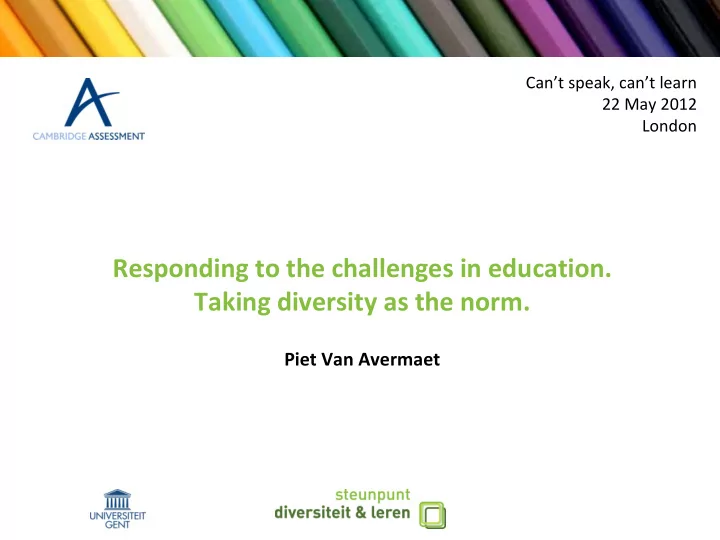

Can’t speak, can’t learn 22 May 2012 London Responding to the challenges in education. Taking diversity as the norm. Piet Van Avermaet
Our fundamental thinking on diversity denies diversity as starting point. Rather, it starts from a binary way of thinking in which one part of the binary is considered as legitimate (not negotiable) norm and the other as the deviant or deficient. A socially constructed hierarchical relationship of powers.
Impacts (Language) education – School policy – Classroom practice Plurilingual repertoires Assessment
Observed school practice Teaching EAL = remedy ‘language deficit’ Pull out classes is common practice Monolingualism is the norm; plurilingualism is a problem (for school success (e.g. PISA) A child with ‘low proficiency of EAL’ = often observed as ‘poor’ or ‘weak’ (in skills, aptitude,…)
Children acquire socially determined language repertoires. For some a mismatch between the input at home and the norms, codes and interaction patterns that are seen as legitimate in education and school can be observed. Only focusing on language ‘remedying’ reduces this mismatch to a ‘problem’ of the child and a problem of ‘language’. It puts different repertoires of children in a hierarchical order. To remedy starts from idea of homogeneous groups as ideal
A lot of empirical evidence for the power of heterogeneity and co operative learning environments: powerful for the ‘weaker’ and ‘average’ learner. Not negative for the stronger learner Heterogeneity as an asset for learning Norms, codes, interaction patterns and ways of unraveling knowledge are negotiable. A school adapts its teaching methods to the observed diversity, so that it can compensate for the children’s differences. In this way, the school adapts its teaching method to the students rather than the students to the school.
Plurilingualism: what do we observe? Plurilingualism is often seen as a problem, a deficit, no language At school often only allowance of standard variety of the host language (L2) Promotion of foreign languages (FL) as an asset in Europe versus immigrants L1 as a handicap, a disadvantage FL as a means for cognitive development versus home language as an obstacle for school success However, plurilingualism is reality in schools
Functional plurilingual learning plurilingual repertoires as didactical capital for learning: functional use of home languages in multilingual, L2 ‐ dominant environments – ‘Scaffolding’ ‐ model: L1 as a tool for learning – Empirical research: casestudies on L1 ‐ using mediation strategies in L2 ‐ teaching; strong interdependency L1 ‐ L2
Testing A test is an attempt to measure reality. This reality is embedded in social reference frames. Consequently, each test is a social construct. Tests are never neutral, objective, value ‐ free. Sometimes used as mechanism for exclusion; to keep children out of the regular classroom and in the pull out classes Focus on what children cannot instead on what they can
Broadly based assessment Product and process What candidates can instead of what they cannot Mapping development Capturing individual learning paces (take into account the heterogeneity of the group) – Learning processes are whimsical and individually different Assessment is integrated in the learning and teaching process (continuous instead of only a snapshot) Students are actively involved in the development and performance of the assessment
Avoid separate EAL curriculum: – only for newcomers – For a short period in time Integration in mainstream classes Keep in mind that EAL learning is a continuous process occurring in context and takes average 9 ‐ 12 years. This is not about language only. This is about we deal with social inequality in education Professionalize teachers to teach and assess in diverse, plurilingual and heterogeneous contexts Develop tools to teach and assess diverse, plurilingual and heterogeneous contexts
Can’t speak, can’t learn 22 May 2012 London THANK YOU piet.vanavermaet@ugent.be
Recommend
More recommend